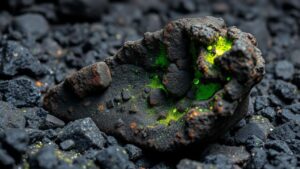Investigating garnet-rich schists in the remote terrains of Alaska’s Wrangell Mountains.
Investigating Garnet-Rich Schists in Alaska’s Wrangell Mountains
The remote terrains of Alaska’s Wrangell Mountains are a haven for rockhounds and mineral collectors alike, particularly due to the presence of garnet-rich schists. These unique geological formations offer an exciting opportunity for enthusiasts seeking to explore, collect, and understand these fascinating minerals. In this article, we will delve into the characteristics of garnet-rich schists, their geological significance, and practical tips for collectors venturing into this rugged landscape.
The Geology of Garnet-Rich Schists
Schists are a type of metamorphic rock characterized by their foliation and the presence of larger mineral grains. Garnet-rich schists contain a notable concentration of garnet, a silicate mineral commonly found in high-grade metamorphic rocks. These schists often form under significant pressure and temperature conditions typical of regional metamorphism.
In the Wrangell Mountains, garnet-rich schists primarily consist of the mineral almandine, known for its deep red to purple hues. The formation of these schists can be traced back to the Paleozoic era, with some estimates suggesting an age of over 300 million years. r unique mineral composition is a result of tectonic activity and the subduction of oceanic crusts, leading to the metamorphic transformation of sedimentary precursors.
Key Features of Garnet-Rich Schists
Collectors should note several distinguishing features of garnet-rich schists that can aid in identification:
- Color: The predominant garnet typically presents in shades of red, though other minerals may add contrasting colors.
- Texture: Schists are generally characterized by a shiny, flaky appearance due to the alignment of mica and garnet crystals.
- Hardness: Garnets have a hardness of 7.5 to 8 on the Mohs scale, making them relatively durable for collectors.
Noteworthy Locations for Collection
The Wrangell Mountains are vast, encompassing numerous locations worth exploring for garnet-rich schists. Some notable areas include:
- Mount Sanford: This volcanic mountain has exposed schists, particularly in its foothills.
- Chitina Valley: Accessible via rough roadways, this area features both garnet and associated minerals.
- Wrangell-St. Elias National Park: With its expansive wilderness, this park offers a plethora of schist exposure.
Always ensure to check local regulations and obtain necessary permits when collecting in these areas, especially those within national parks.
Practical Tips for Collectors
For rockhounds eager to dive into the garnet-rich schists of the Wrangell Mountains, consider the following practical tips:
- Equipment: Bring a rock hammer, chisel, safety goggles, and appropriate hiking gear. A portable GPS or map can aid in navigation.
- Field Techniques: Look for outcroppings where schist layers are visible. Scraping the surface can reveal garnet crystals embedded within.
- Identification: Familiarize yourself with the visual traits of garnets versus similar minerals, such as other red or brown stones.
Environmental Considerations
As you plan your expedition, its imperative to be mindful of the environment. The Wrangell Mountains are home to sensitive ecosystems. Collectors should adhere to Leave No Trace principles, including:
- Avoiding disturbance of wildlife habitats
- Minimizing surface impact and not trampling vegetation
Conclusion and Takeaways
Investigating garnet-rich schists in Alaska’s Wrangell Mountains presents a rewarding adventure for rockhounds and mineral collectors. With their unique geological background, striking visual characteristics, and accessibility, these schists offer both educational and practical opportunities for collectors. Remember to equip yourself adequately, respect the environment, and take home only memories and responsibly collected specimens.
Embarking on this endeavor not only enhances your collection but also deepens your appreciation for the geological wonders that the Wrangell Mountains provide.



